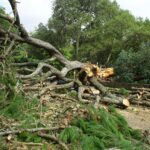At a glance:
- Pruning can cause a tree to die if done improperly, which can result in significant damage to the tree and even death.
- Trees that are already stressed or diseased are more likely to die from pruning, as they may not have the resources to recover from the pruning.
- Proper pruning techniques, timing, and after-care can help prevent tree death from pruning and promote healthy growth. Hiring a professional arborist and monitoring the tree for signs of stress or damage can also help ensure the tree’s health and longevity.
Overview of tree pruning
Tree pruning has both positive and negative effects on trees. Although it promotes healthy growth and improves a tree’s appearance, improper pruning techniques can cause significant damage and even death.
When trees are pruned, they lose a significant amount of leaves, branches, and wood, which can cause stress and hinder recovery time. Over-pruning can weaken the tree, making it more susceptible to disease and pests. Improper pruning techniques can lead to the formation of decay pockets or cavities, which can weaken the tree’s structure, thus increasing the risk of failure.
Different tree species have varying degrees of resilience to pruning. Fruit trees such as apple and peach trees are more tolerant of aggressive pruning to promote fruit production. Eucalyptus, Acacia, Melaleuca, Callistemon (Bottlebrush), Banksia, and Grevillea are some of the Australian tree species that generally tolerate pruning well, as they are adapted to cope with regular disturbances such as bushfires, wind damage, and animal browsing. Proper pruning techniques are vital in maintaining a tree’s health, and it’s crucial to understand the risks of improper pruning to avoid causing damage or stress to the tree.
Benefits of proper pruning:
Promotes healthy growth:
Pruning helps remove dead or diseased branches, which allows the tree to allocate its resources towards healthy branches. This can promote new growth and improve the tree’s overall health.
Improves tree appearance:
By removing overgrown or awkwardly placed branches, pruning can give the tree a more balanced and aesthetically pleasing shape.
Reduces risk of damage or failure:
Pruning removes weak or structurally unsound branches, which can improve the tree’s overall structure and reduce the risk of branches breaking or falling during storms or high winds.
Promotes fruit production:
In certain tree species, pruning can redirect the tree’s energy towards producing larger and higher-quality fruit.
Risks of improper pruning:
Damage or stress to the tree:
Improper pruning techniques, such as topping or removing too much of the tree, can cause significant damage and even kill the tree. This can include damage to the bark, branches, or trunk and can make the tree more susceptible to pests and disease.
Loss of aesthetic value:
Over-pruning or pruning at the wrong time of year can affect the tree’s appearance and reduce its aesthetic value.
Increased risk of failure:
Improper pruning can create weak or structurally unsound branches, which can increase the risk of branches breaking or falling during storms or high winds.
Reduced lifespan:
Trees that are improperly pruned may be more susceptible to disease, pests, and other stressors, which can reduce their lifespan.
To avoid these risks, it’s important to hire a professional arborist who has the knowledge and experience to prune trees properly. An arborist will know how much of the tree can be safely pruned and will use proper pruning techniques to minimise damage to the tree.
Can pruning cause a tree to die?
Yes, pruning can cause a tree to die if it’s done improperly or excessively. When a tree is pruned, it loses leaves, branches, and wood, which can be stressful for the tree. If too much of the tree is removed during pruning, it can weaken the tree, making it more susceptible to disease and pests. Improper pruning techniques can also lead to physical damage, such as the formation of decay pockets or cavities, which can weaken the tree’s overall structure and increase the risk of failure. It’s important to hire a professional arborist and use proper pruning techniques to reduce the risk of tree death from pruning.
Factors that increase the risk of death from pruning
Pruning trees can be a hazardous task that poses a risk to workers and the tree’s health if not done correctly. Certain factors increase the risk of death from pruning, including:
Age and condition of the tree:
Older trees or trees with pre-existing conditions such as decay or disease are more vulnerable to stress from pruning and may be at higher risk of death.
The extent of pruning:
Removing too many branches, especially large ones, can cause severe stress and damage to the tree, making it more susceptible to pests and diseases.
Timing and Weather:
Pruning during periods of high stress, such as drought or extreme weather, can weaken the tree and increase the risk of death.
Environmental factors:
The proximity of power lines, buildings, or other obstacles can make pruning more challenging and increase the risk of accidents or damage to the tree.
To mitigate these risks, proper planning, equipment, and techniques are essential. A risk assessment should be conducted before any pruning work is carried out to identify potential hazards and determine appropriate control measures. Training, protective gear, and communication protocols should also be in place to ensure the safety of workers and bystanders. Proper pruning practices can help maintain a tree’s health and vitality while minimising the risk of death or damage.
Types of trees that may be more vulnerable to death from pruning.
Certain types of trees may be more vulnerable to death from pruning than others. Some of these trees include
Conifers:
Pruning conifers can be risky, as they do not heal, as well as deciduous trees. Removing large branches can create wounds that do not close, making them more susceptible to disease and pests.
Flowering trees:
Flowering trees, such as magnolias and cherries, are often pruned for aesthetic purposes. However, over-pruning can cause significant damage and weaken the tree’s structure, increasing the risk of death.
Fruit trees:
Fruit trees, such as apple and peach trees, are often pruned to promote fruit production. While they can tolerate more aggressive pruning than other tree species, improper pruning can cause damage and increase the risk of death.
Old or weakened trees:
Older or weakened trees may be more vulnerable to death from pruning due to the stress caused by removing significant amounts of wood and foliage.
Proper pruning techniques are essential for maintaining a tree’s health and minimising the risk of death. Pruning should be done during the tree’s dormant season and in a way that promotes healthy growth and development. Regular inspections and maintenance can also help identify potential issues and prevent damage.
Signs that a tree may be dying as a result of pruning
While proper pruning techniques can promote healthy growth and improve a tree’s appearance, improper pruning can cause significant damage and even death. Here are some signs that a tree may be dying as a result of pruning:
Reduced foliage:
If a tree’s canopy is significantly reduced after pruning and fails to regrow leaves, it may be a sign that the tree is dying.
Dead branches:
If a tree’s branches start to die after pruning, it may indicate that the tree is not recovering properly and is at risk of dying.
Decay:
Improper pruning can lead to decay in the tree, which may be visible as dark spots, holes or cavities in the trunk or branches.
Insect infestation:
Trees that are stressed or weakened by pruning are more vulnerable to insect infestations. If you notice an increase in pests, it may be a sign that the tree is not recovering well from pruning.
Leaning or cracking:
If a tree begins to lean or crack after pruning, it may be a sign that the tree is structurally compromised and at risk of falling.
It’s important to note that these signs can also be caused by other factors, such as disease or environmental stress. If you suspect that your tree is dying as a result of pruning, it’s best to contact a certified arborist to assess the tree’s condition and determine the best course of action.
Preventing tree death from pruning:
Hiring a professional arborist
Hiring a professional arborist is important for preventing tree death from pruning because they are trained and experienced in proper pruning techniques and can identify the specific needs of each tree species. They have the necessary knowledge and skills to safely prune trees without causing damage or stress to the tree. Professional arborists also have the right equipment to prune trees efficiently and safely. They’ll provide your tree with proper after-care advice and monitor the tree for signs of stress or damage. Overall, hiring a professional arborist can ensure that the tree is pruned correctly, minimising the risk of tree death from pruning.
In Melbourne, Australia, you can search for “tree pruning near me” or “tree pruning services Melbourne” to find a list of reputable and affordable tree service providers in your area.
Using proper pruning techniques
Proper pruning techniques involve making careful and deliberate cuts to ensure the health and safety of the tree. Some of the techniques are:
Using sharp tools:
Dull pruning tools can crush or damage the tree’s bark, which can leave the tree more susceptible to pests and diseases.
Making the right cuts:
The size and angle of the cut are crucial. A clean cut should be made just outside the branch collar, which is the raised area where the branch connects to the trunk or another branch.
Avoiding topping:
Topping, or cutting off the entire top of the tree, is a harmful practice that can weaken the tree and make it more susceptible to pests and diseases.
Pruning at the right time:
Pruning at the right time can help the tree recover more quickly and prevent stress. Generally, it’s best to prune during the dormant season or just after flowering.
Balancing the crown:
Removing too many branches from one side of the tree can make it lopsided and increase the risk of failure during high winds. It’s important to balance the tree’s crown by removing branches evenly.
Types of pruning:
Here are some types of pruning:
Crown Thinning:
This technique involves selectively removing branches from the crown of the tree to reduce its density while maintaining its natural shape. It is usually done to improve light penetration and air circulation throughout the tree.
Crown Raising:
This technique involves removing the lower branches of a tree to provide clearance for vehicles, pedestrians, and other structures. The amount of pruning should be balanced to avoid removing too many branches, which can weaken the tree’s structure.
Crown Reduction:
This technique involves the removal of the tree’s larger branches to reduce the tree’s overall size while preserving its natural shape. It is usually done to address structural problems, limit damage caused by weather events, and prevent the tree from obstructing views.
Pollarding:
This technique involves removing the upper branches of a tree to encourage the dense growth of new branches at the tree’s top. It is commonly used to create a uniform size of trees in street-scapes or formal garden settings.
Espaliering:
This technique involves the shaping of a tree or shrub by tying its branches to a frame or wall. It is usually done to save space or to create an attractive feature on a wall or trellis.
Pruning at the right time
When pruning a tree largely, one must consider the specie and the season for pruning. A general rule of thumb is to prune during the dormant season, which is usually in the winter. During the dormant season, trees are less susceptible to damage and diseases, and pruning can promote healthy growth in the spring.
It’s important to avoid pruning during the hottest months of summer, as this can cause stress to the tree and increase the risk of sunscald. Some species, such as spring-flowering trees, should be pruned immediately after flowering to avoid removing next year’s buds.
On the other hand, some fruit trees should be pruned in late summer to promote fruit production. It’s always best to research the specific tree species and consult with a professional arborist to determine the best time for pruning.
Proper after-care for the tree
Post-pruning care is crucial to ensure the tree remains healthy and recovers from the stress caused by pruning. After pruning, it is important to water the tree regularly, especially during hot and dry weather, to help it recover and promote new growth.
Applying a layer of organic mulch around the tree can help retain moisture and regulate soil temperature. It’s also essential to avoid damaging the tree’s bark or roots during maintenance work. Pruning cuts should be made flush with the branch collar to promote healing and prevent rotting. It’s best to avoid using wound dressings or sealants, as they may actually inhibit the tree’s natural healing process.
Finally, it’s important to monitor the tree for signs of stress or damage after pruning and take appropriate action if needed, such as providing additional water or fertilisation.
Monitoring the tree for signs of stress or damage
After pruning, it’s important to monitor the tree regularly for any signs of stress or damage. Signs of stress include wilting leaves, discolouration, and early leaf drop. Damaged areas may appear as cracks, wounds, or decay. Check the tree for any signs of insect or disease infestations as well.
If you notice any of these symptoms, take prompt action to address the issue. Provide the tree with extra water and fertiliser if needed, and remove any dead or diseased wood. If the issue is severe or you’re not sure how to proceed, it’s best to consult with a certified arborist or tree care professional.
Regular monitoring of the tree can help you identify and address any problems before they become more serious and potentially fatal to the tree.
Conclusion:
In conclusion, pruning is an important part of tree maintenance but can also be dangerous if not done correctly. Improper pruning techniques can lead to significant damage or even death of the tree. To prevent this, it’s important to hire a professional arborist who has the necessary skills and equipment to safely and effectively prune your trees. Proper pruning techniques include avoiding pruning too close to the trunk, cutting at the right angle, and avoiding the removal of large branches. Pruning at the right time of year is also crucial, as it can affect the tree’s growth and health. Proper after-care for the tree, such as watering regularly and applying pruning sealant to old wounds, can help the tree recover from the pruning process. Finally, monitoring the tree for signs of stress or damage after pruning is essential, as it can indicate whether the tree is recovering or if further action is needed. By following these tips, you can ensure that your trees stay healthy and beautiful for years to come.





